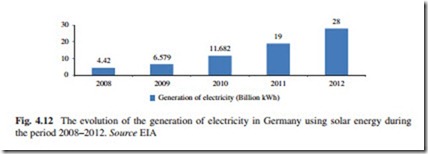Germany
Germany is not a country with incredible amounts of solar energy—what they do have is an excellent subsidizing framework, which ensures that solar energy can compete on the market. With a well-developed FiT scheme, small- and large- scale solar PV systems can send excess electricity production to the utility grid for profit. Germany has imported more lignite coal and nuclear energy from its neighbors since the Fukushima Daiichi nuclear disaster pushed it to begin closing its aging nuclear power reactors and to decide that remaining nuclear power reactors in operation should be closed before 2022. But it is still exporting one source of electricity to France: solar energy. In other words, huge quantities of electricity generated by solar PV power plants in Germany are helping to meet the peak electricity demand in France.
According to the Global Market Outlook for Photovoltaic until 2015 report, in 2010, Germany was again the country setting the global PV pace with 7.4 GW installed and a national target of 51 GW for 2020.12 With added capacity of about 3,800 MW, Germany was again the world’s solar PV champion. A total of 6.6 TWh of electricity was generated by solar PV systems, putting the solar PV share of total energy generation above 1 % for the first time. The addition of the solar thermal collector area, at about 1.6 million m2, remained at a high level. All in all, nearly 13 million m2 of such collector area was in place at the end of 2009. However, in 2013, the decline of Germany and Italy as the main drivers of the European market was confirmed. While the sum of the market in other countries remained around 6 GW, the drop in solar PV installations in Germany and Italy decreased the total European market to nearly 11 GW.13
On the other hand, and despite the reduction in the installations of new solar PV power plants, Germany, with the lowest solar PV system prices on the market and FiTs also among the lowest (an average €0.26 per kWh produced), continues to attract investors for the installations of new solar PV capacities.
Solar Power Installed Capacity
Germany has by far the highest capacity of solar PV power in the world at 32.4 GW (32.37 %) at the end of 2012.14 Newly connected solar PV systems worth 7.6 GW were added that year. The solar power capacity installed in the country at the end of 2012 represents 19.25 % of the total power capacity installed and 43.21 % of the total renewables capacity installed in Germany in that year. The country occupies the place number one at world and regional levels, according to the solar power capacity installed. During each of the past ten years, has increased the energy capacity of the country, particularly the solar capacity installed.
Electricity Generation Using Solar Energy
Germany’s solar panels generated about 28 TWh of electricity in 2012, which is impressive, but still only covers 4.2 % of the country’s total electricity generation. Market analysts believe this number will increase to 25 % before 2050. Germany aims for a total capacity of 66 GW by 2030 with an annual growth between 2.5 and 3.5 GW.
The evolution of the generation of electricity in Germany using solar energy during the period 2008–2012 is shown in Fig. 4.12.
According to Fig. 4.12, the generation of electricity in Germany using solar energy during the period 2008–2012 increased 6.3-fold. It is expected that the use of solar energy for the generation of electricity in Germany will continue to increase in the future, albeit at a slower speed than in previous years, as a result of the implementation of the additional measures adopted by the government. The aim of these measures is to increase the role of renewables in the energy mix of the country during the coming years, particularly after the decision of the government to shut down all nuclear power reactors operating in the country before 2022.
